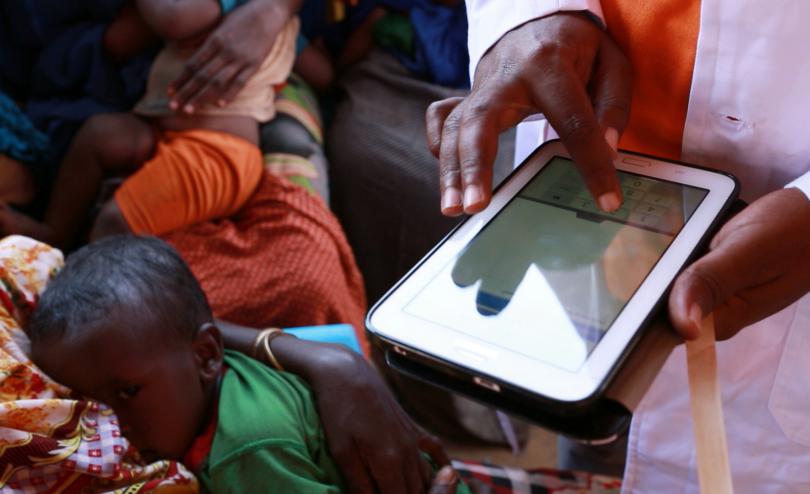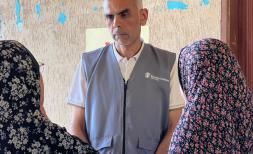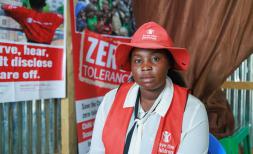Safeguarding migrant and displaced children in a digital world

The COVID-19 pandemic has brought many millions of people around the world online and accelerated the pace and uptake of technological innovation in unforeseen ways.
Innovations in data and technology offer opportunities for positive and transformative change in our sector. Our humanitarian and development programmes increasingly rely on the internet, data and new technologies to reach more people and assist vulnerable and geographically dispersed populations, including displaced children on the move.
And those displaced people are using technology to keep themselves informed, access information and communicate – with each other, with authorities and with us as development actors.
Now, more than ever, we are using digital technologies to conduct lessons for children, using apps to gather data for our health programmes and developing software for case management and registration.
However, with technical innovation comes ethical dilemmas and increased threats to the safety and wellbeing of children. Migrant and refugee children are among the most vulnerable groups susceptible to these threats.
The new report from Save the Children’s Migration and Displacement Initiative, Digital Safeguarding for Migrating and Displaced Children, describes the digital safeguarding risks and current digital safeguarding practices alongside clear recommendations and practical next steps.

Yazan*, 7 years old, takes photos on a staff member's phone after a day in Zaatari Camp's Kindergarden.
What digital risks are migrant and displaced children facing?
According to UNICEF’s 2017 ‘State of the World’ report, nearly nine in 10 young people in Africa, Asia and the Pacific aren’t using the internet. Even when they do have access to a device, they may not use the internet due to poor connectivity and high data costs. As a sector, we risk contributing to this ‘digital divide’. Children without sufficient access to technology or devices risk exclusion from valuable services like distance learning, mental health and psychosocial services or reunification programmes for families who were separated as they fled from conflict.
Big data and tech-based programmes focused on humanitarian innovation and experimentation may also prioritise product development at the expense of the needs of children. This coupled with the comparative technical inexperience of the aid sector may result in personal data being inadvertently misused or mishandled.
Private sector companies have been known to sell personal data that is then used by government agencies and others to identify and track individuals and their families, for purposes including deportation. Multiple cases have been reported of the US Immigration and Customs Enforcement using children’s data to track down and arrest immigrants.
Moreover, aid agencies may unwittingly share personal information – such as case management files or health information – with local government or national immigration authorities. This puts children at risk of deportation or, in extreme cases, death. The collection and sharing of sensitive data such as biometrics or DNA bring even more ethical risks and have been banned by NGOs in some instances.

Alejandra*, 15, plays on her mobile phone inside her bedroom in El Salvador.
Social media brings a number of additional risks to children. Social media messaging and propaganda can be designed to recruit young people into armed conflict or gangs. Smugglers and traffickers have been known to use social media to pose as NGOs tasked with organising safe passage to Europe by sea or use WhatsApp for prostitution activity, as reported in Serbia. As a sector, we too can inadvertently expose children to these groups when engaging with them through social media.
What can we do to ensure that every migrant and displaced child stays safe?
We have a collective responsibility to protect children online as well as offline, so our safeguarding policies and practices need to be re-framed and strengthened for the digital world.
The aid sector is lagging behind donors and corporate partners when it comes to capacity and resources to address the complex mix of technologies and risks. We urgently need to address this to keep up with a rapidly changing digital landscape by investing in staff training, developing clear agreements with partners, conducting proper risk assessments and implementing common data management systems.
The worrying lack of trust among young people in how their data is handled, which can cause young people to exclude themselves from crucial programmes, is of critical concern. It’s essential that we engage with young people and their communities before the introduction of new devices, programmes or data collection approaches to ensure that their concerns are addressed and trust is established.

Dayana's school is closed due to the pandemic so she has to study from home using her mobile phone. Dayana is a 15-year-old girl who lives in the Sonsonate region in El Salvador.
In early 2021, Save the Children will address these issues by creating a new set of practical guidance for programmes in the digital age, ensuring that staff who work most closely with migrating and displaced children have the skills and resources they need to keep those children safe.
We have a solid foundation upon which to lead the sector in building a more robust digital safeguarding effort, and we must mobilise and collaborate with the other aid actors to build sector-wide norms on how to keep children safe when we conduct digital programming.
The past year has shown us that the world – and the digital space – is changing at pace. We have to be ready, at the forefront of technology, to ensure that every child, everywhere, is protected from harm.
Read our new report: Digital Safeguarding for Migrating and Displaced Children.
Save the Children’s Migration and Displacement Initiative (MDI) leads Save the Children’s global efforts to ensure lasting improvement in the lives of migrant and displaced children.







